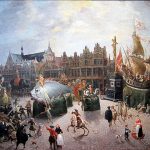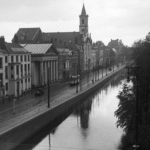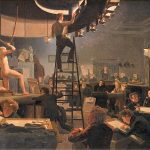
The Royal Academy of Fine Arts in Antwerp, Belgium, is one of the most esteemed and historic art institutions in the world. Established in 1663, it has played a crucial role in shaping the landscape of fine arts, fashion, and design for centuries. Nestled in the heart of Antwerp, a city celebrated for its artistic heritage, the Academy has nurtured generations of painters, sculptors, designers, and visionaries. Its legacy extends beyond Belgium, influencing global art movements and establishing itself as a cornerstone of artistic education.
Antwerp has long been a center of artistic innovation, home to legendary painters such as Peter Paul Rubens and Anthony van Dyck. The Academy was founded during this golden age of Flemish art and has continued to uphold its rich traditions while evolving with the changing tides of artistic expression. Over the centuries, it has been instrumental in the development of Neoclassicism, Romanticism, Expressionism, and Surrealism, among other movements. The Academy’s curriculum has continually adapted, blending classical techniques with modern innovations.
Today, the Academy remains a beacon for aspiring artists from around the world, offering specialized programs in fine arts, fashion, graphic design, and multimedia. The school’s ability to balance traditional artistic mastery with contemporary creative practices has made it a sought-after institution for students looking to push the boundaries of artistic expression. Many of its alumni have gone on to become pioneers in their respective fields, leaving an indelible mark on the global arts scene.
This article explores the Academy’s historical evolution, notable alumni, role in fashion and design, modern contributions, and impact on Antwerp’s cultural identity. From its humble beginnings as a small academy for painters and sculptors to its rise as a premier institution for art and design, the Royal Academy of Fine Arts continues to shape the future of creativity.
The Founding of the Royal Academy of Fine Arts
The Royal Academy of Fine Arts of Antwerp was established in 1663 by David Teniers the Younger, a renowned Flemish painter and court artist to Archduke Leopold Wilhelm of Austria. At the time, Antwerp was a flourishing center of Baroque art, producing some of the most influential artists of the period. Teniers envisioned an institution that would provide structured artistic education, moving away from the traditional guild-based apprenticeships that dominated European art training. His goal was to elevate artistic standards and establish a school where painters, sculptors, and architects could refine their craft.
Initially, the Academy was a modest institution, focusing primarily on classical drawing and painting techniques inspired by the Italian and Flemish masters. It was modeled after other leading European academies, such as the Accademia di San Luca in Rome and the Académie Royale de Peinture et de Sculpture in Paris. The curriculum was designed to teach proportion, anatomy, and perspective, essential foundations for any aspiring artist. The Academy’s faculty included some of the most skilled artists of the time, ensuring that students received the highest quality training available.
As Antwerp’s reputation as an artistic hub continued to grow, so did the Academy. By the 18th century, the institution had expanded its focus beyond painting and sculpture, incorporating engraving, printmaking, and architectural studies. This broadened the scope of artistic disciplines taught within its walls, further solidifying its status as a premier center for artistic education. The shift towards a more academic approach to art was a direct response to the Enlightenment ideals sweeping through Europe, emphasizing reason, structure, and formal artistic training.
The Academy’s role in the transition from guild-based craftsmanship to structured artistic education was transformative. Prior to its establishment, artists were trained through a master-apprentice system, where skills were passed down within closed workshops. The creation of the Academy provided open access to artistic training, making it possible for talented individuals from all backgrounds to pursue art professionally. This democratization of artistic education laid the foundation for the Academy’s enduring influence in the centuries to come.
Evolution Through the Centuries
Throughout the 18th and 19th centuries, the Royal Academy of Fine Arts evolved into a prestigious institution that attracted students from across Europe. As artistic styles shifted, so did the Academy’s teaching methods. The influence of Neoclassicism, which emphasized harmony, idealized forms, and a return to Greco-Roman artistic principles, became prominent in the curriculum. Professors at the Academy encouraged students to study classical sculptures and Renaissance masterpieces, ensuring they mastered the techniques of the Old Masters before exploring their own creative styles.
During the 19th century, the Academy played a significant role in the rise of Romanticism and Realism in Belgium. The rigid classical ideals of the previous era began to give way to more expressive and emotionally charged art forms. Many students of the Academy, including Gustave Wappers and Henri Leys, became leading figures in the Belgian Romantic movement. Their works reflected a deep interest in history, mythology, and dramatic compositions, aligning with the broader artistic trends of the period.
The 20th century brought another wave of transformation as the Academy embraced modernism. Art movements such as Expressionism, Surrealism, and Abstraction found a place within its walls, challenging traditional notions of beauty and representation. Artists like James Ensor and René Magritte, both associated with the Academy, played a pivotal role in shaping Belgian and international modern art. This period marked a departure from strict academic training, allowing students greater creative freedom to explore new artistic concepts and techniques.
By the late 20th and early 21st centuries, the Academy had diversified its programs even further, incorporating graphic design, photography, multimedia arts, and digital animation. The institution recognized the growing importance of technology in the arts and adapted accordingly. Today, students at the Academy engage with virtual reality, digital painting, and experimental media, blending traditional fine arts education with cutting-edge innovation. This ongoing evolution has ensured the Academy’s continued relevance in the ever-changing world of contemporary art.
Notable Alumni and Their Contributions
The Royal Academy of Fine Arts has produced some of the most celebrated artists, designers, and architects in history. One of the most famous figures associated with the Academy is Vincent van Gogh, who briefly studied there in 1886. Although he only attended for a short time, his experience at the Academy exposed him to new techniques and ideas that influenced his later works. Despite his unconventional approach, van Gogh’s legacy remains deeply connected to the Academy’s reputation for fostering artistic brilliance.
Another major name linked to the Academy is James Ensor, a pioneering Expressionist and Symbolist artist known for his grotesque, fantastical imagery. His bold use of color, eerie masked figures, and unique subject matter distinguished him as one of Belgium’s most important modern artists. His works, including The Entry of Christ into Brussels in 1889, challenged traditional artistic conventions and prefigured the rise of Surrealism and Dadaism.
The Academy also played a role in the development of René Magritte, one of the foremost Surrealist painters. Magritte’s studies at the Academy provided him with a strong foundation in draftsmanship and composition, which later contributed to his meticulously crafted dreamlike paintings. His enigmatic works, such as The Son of Man and The Treachery of Images, remain among the most recognizable pieces in modern art history.
In addition to fine artists, the Academy has produced leading figures in architecture and design, including Henry van de Velde, a visionary of the Art Nouveau movement. Van de Velde’s innovative approach to design, combining functionality with artistic elegance, laid the groundwork for modernist architecture and industrial design. His influence extended beyond Belgium, contributing to the Bauhaus movement in Germany. These alumni represent just a fraction of the Academy’s immense artistic legacy.
The Academy’s Role in Fashion and Design
The Royal Academy of Fine Arts is not only known for its contributions to fine arts but has also become one of the world’s most influential institutions in fashion design. This transformation began in 1963, when the Academy formally introduced a fashion department, a move that would eventually place Antwerp at the center of global fashion innovation. The department was established to combine artistic creativity with technical expertise, encouraging students to push the boundaries of textile design, garment construction, and conceptual fashion. Over the decades, the Academy’s fashion program has produced some of the most revolutionary designers in the industry.
One of the most defining moments in the Academy’s history came in the 1980s with the rise of the Antwerp Six, a collective of avant-garde fashion designers who had all studied at the Academy. This group—Dries Van Noten, Ann Demeulemeester, Walter Van Beirendonck, Dirk Van Saene, Dirk Bikkembergs, and Marina Yee—gained international recognition after showcasing their designs at London Fashion Week in 1986. Their innovative approach to silhouettes, fabric manipulation, and deconstruction challenged traditional fashion norms, marking Antwerp as a major hub for experimental fashion.
Following the success of the Antwerp Six, the Academy’s reputation in fashion continued to grow. Other prominent graduates, such as Raf Simons, further cemented its status as a fashion incubator for avant-garde talent. Simons, initially trained in industrial design, transitioned into fashion after studying at the Academy and later became the creative director of Dior and Prada. His influence on minimalism, tailoring, and youth culture in fashion showcases the Academy’s ability to nurture designers who redefine industry standards.
Today, the fashion department remains one of the Academy’s most competitive and prestigious programs, attracting students from around the world. The curriculum emphasizes conceptual development, technical skill, and historical awareness, ensuring that graduates leave with a strong artistic vision and a deep understanding of garment construction. The Academy’s success in merging fine art with fashion has allowed it to remain at the forefront of global design innovation, continually shaping the future of couture, ready-to-wear, and sustainable fashion.
The Academy’s Campus and Facilities
The Royal Academy of Fine Arts is housed in a blend of historic and modern buildings, reflecting its commitment to both tradition and innovation. Located in the center of Antwerp, the Academy’s main campus is an architectural landmark, featuring ornate facades, grand studios, and exhibition spaces. The main building, originally constructed in the 19th century, has been preserved as a tribute to the Academy’s long-standing legacy, while recent renovations have introduced state-of-the-art facilities for contemporary art and design education.
Within the campus, students have access to specialized workshops, high-tech studios, and expansive art libraries. The painting and sculpture studios remain essential to the Academy’s fine arts curriculum, offering spaces where students can practice traditional techniques such as oil painting, printmaking, and bronze casting. Meanwhile, modern disciplines such as digital animation, video production, and 3D modeling are supported by cutting-edge technology, ensuring that students can engage with both classical and contemporary artistic methods.
One of the most notable aspects of the Academy is its gallery and exhibition spaces, where students and faculty regularly showcase their work. The Academy Gallery, located on the main campus, provides a professional setting for exhibitions, installations, and fashion presentations. These public showcases allow students to engage with a broader audience, receive critical feedback, and prepare for careers in the global art and design industry. The Academy also maintains close ties with local museums, such as the Royal Museum of Fine Arts Antwerp, further enriching students’ exposure to historical and contemporary art collections.
In addition to its physical resources, the Academy offers research and collaboration opportunities with leading institutions worldwide. Through its partnerships with other top art schools, museums, and industry professionals, the Academy fosters an environment where students can develop their talents beyond the classroom. The combination of historic architecture, cutting-edge facilities, and international networks makes the Academy’s campus one of the most dynamic environments for artistic growth and education.
The Academy in the 21st Century
The Royal Academy of Fine Arts has continuously adapted to remain a leader in art and design education in the modern era. Today, the Academy offers an extensive range of undergraduate and postgraduate programs, covering fine arts, graphic design, photography, multimedia arts, and fashion. The curriculum is structured to provide both technical training and conceptual development, ensuring that students graduate with the skills and artistic vision needed to succeed in a highly competitive field.
A major focus of the Academy in the 21st century has been its international collaborations and exchange programs. Students have the opportunity to participate in global art projects, residencies, and study abroad experiences, working with institutions such as the Royal College of Art in London, Parsons School of Design in New York, and the École des Beaux-Arts in Paris. These international connections enhance students’ exposure to different artistic traditions and contemporary movements, preparing them for multicultural and interdisciplinary careers.
The Academy has also embraced digital transformation, integrating technology into its teaching methodologies. The rise of digital painting, 3D modeling, and virtual reality has led the Academy to develop new courses that explore the intersection of art and technology. In recent years, the school has introduced programs focusing on game design, artificial intelligence in art, and experimental media, ensuring that students remain at the forefront of digital creativity. This commitment to innovation has helped the Academy maintain its global prestige as an institution that nurtures both tradition and modernity.
Looking to the future, the Academy continues to expand its role in shaping contemporary art and design. It remains dedicated to fostering artistic freedom, research, and cross-disciplinary exploration, ensuring that each generation of students contributes to the ongoing evolution of creative expression. As the world of art continues to change, the Royal Academy of Fine Arts stands ready to lead the next wave of artistic breakthroughs.
The Academy’s Influence on Antwerp’s Cultural Scene
Beyond its academic contributions, the Royal Academy of Fine Arts has played a key role in shaping Antwerp’s cultural identity. The city is widely recognized as a hub for art, fashion, and design, due in large part to the Academy’s presence and influence. Over the centuries, the Academy has contributed to local exhibitions, museums, and cultural festivals, fostering a vibrant artistic community that attracts visitors from all over the world.
One of the Academy’s most important contributions to the city is its connection to the Royal Museum of Fine Arts Antwerp (KMSKA). Many Academy alumni have had their works featured in the museum, which houses masterpieces by Peter Paul Rubens, Jacob Jordaens, and James Ensor. The Academy and the museum often collaborate on research projects, exhibitions, and educational initiatives, ensuring that Antwerp’s artistic heritage remains accessible to the public.
In addition to fine arts, the Academy has also shaped Antwerp’s thriving fashion industry. The success of the Antwerp Six and other Academy-trained designers has transformed the city into a fashion capital, attracting major designers, buyers, and critics from around the world. The Academy hosts annual graduate fashion shows, which serve as launchpads for emerging designers looking to enter the international fashion scene. These events have further solidified Antwerp’s reputation as a city that values artistic experimentation and creative innovation.
Beyond institutions and industries, the Academy’s graduates continue to enrich Antwerp’s cultural fabric. Many alumni remain in the city, opening independent studios, galleries, and creative spaces that contribute to a flourishing contemporary art scene. The Academy’s impact on Antwerp is undeniable—it has not only educated generations of artists but has also helped shape the very identity of the city itself.
Key Takeaways
- The Royal Academy of Fine Arts in Antwerp was founded in 1663 by David Teniers the Younger and is one of the oldest art institutions in Europe.
- The Academy has evolved over centuries, influencing Neoclassicism, Romanticism, Expressionism, and modern art movements, while continuously adapting to new artistic trends.
- Many renowned artists and designers studied at the Academy, including Vincent van Gogh, René Magritte, James Ensor, Henry van de Velde, and the Antwerp Six.
- The fashion department, established in 1963, played a pivotal role in Antwerp’s emergence as a global fashion capital, producing world-famous designers.
- Today, the Academy remains at the forefront of art and design education, integrating traditional techniques with modern technology, fostering global collaborations, and shaping Antwerp’s cultural landscape.
FAQs
1. Why is the Royal Academy of Fine Arts in Antwerp famous?
The Academy is famous for its long-standing history in fine arts education, its impact on major art movements, and its prestigious alumni. It is also recognized worldwide for its fashion department, which has produced influential designers such as the Antwerp Six and Raf Simons.
2. Who are some notable alumni of the Academy?
The Academy has trained many renowned artists, including Vincent van Gogh, René Magritte, James Ensor, Henry van de Velde, and fashion designers like Dries Van Noten and Ann Demeulemeester. Its graduates have shaped both fine arts and fashion on a global scale.
3. What programs does the Academy offer today?
The Academy offers undergraduate and postgraduate degrees in fine arts, graphic design, photography, fashion, multimedia arts, and digital animation. It blends classical artistic training with modern technology and conceptual experimentation.
4. How did the Antwerp Six influence fashion?
The Antwerp Six—a group of Academy-trained designers—gained international recognition in the 1980s for their avant-garde and deconstructed fashion styles. Their success helped establish Antwerp as a global fashion capital, influencing contemporary fashion trends worldwide.
5. How does the Academy contribute to Antwerp’s cultural scene?
The Academy collaborates with local museums, galleries, and cultural institutions to organize exhibitions, public art projects, and student showcases. It has significantly influenced Antwerp’s reputation as an artistic and fashion-forward city, attracting creatives from around the world.




